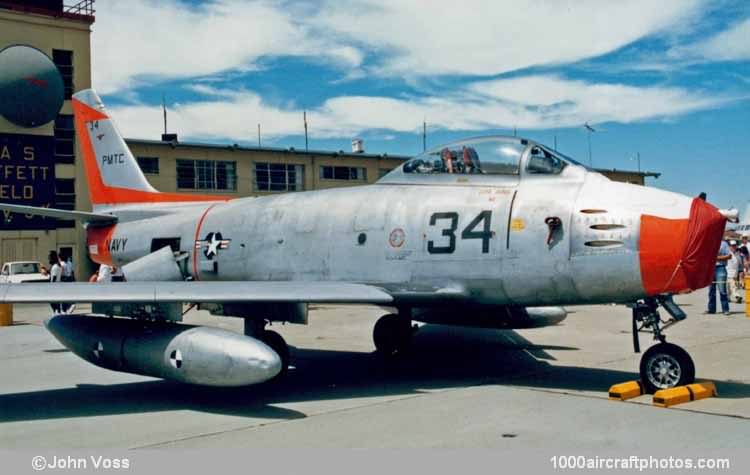07/31/2013. Remarks by Johan Visschedijk: "A day-fighter, the F-86F was basically an F-86E modified to incorporate the General Electric J47-GE-27 engine of 5,910 lb (2,681 kg) st, instead of the J47-GE-13 powering the F-86A and F-86E. The new engine gave the F-86F a top speed of 688 mph (1,107 kmh) at sea level, an initial rate of climb of 9,300 ft (2,834 m)/min and a service ceiling of 48,000 ft (14,630 m).
The first of 78 F-86F-1-NA first flew on March 19, 1952 (the NA suffix indicated built at the Los Angeles plant, those built at Columbus had the NH suffix). During the production runs of the F-86F improvements were embodied to produce sub-variants. Under 'Gun-Val', a project for increasing the Sabre firepower, six F-86F-1-NAs were fitted with four 0.787 in (20 mm) Springfield T-160 cannon, in place of the normal 0.50 in (12.7 mm) machine guns, and redesignated F-86F-2-NA, and two F-86F-1-NAs were fitted with four 0.787 in (20 mm) Oerlikon 206RK cannon, and redesignated F-86F-3-NA.
The sixteen F-86F-5-NAs differed in having underwing shackles capable of handling 200 gal (757 l) drop tanks instead of the earlier 120 gal (454 l) tanks. These increased the combat radius from 430 to 463 mls (692 to 745 km). The F-86F-10-NA embodied a new gunsight, the A-4, which used the same radar as the A-ICM but was simpler to maintain in service; 34 were built. Only seven of the 100 intended F-86F-15-NAs with re-positioned control systems were built, the remaining 93 were fitted with the earlier J47-GE-13 engines and redesignated F-86E-15-NA. The F-86F-20-NH could carry two 200 gal (757 l) drop-tanks and had armor protection for the elevator control system, plus other minor differences; 100 were delivered.
The F-86F-30-NA was a fighter-bomber version, with a 'dual store' wing with attachment points for two drop tanks or other stores under each wing instead of one. With two 200 gal (757 l) tanks and two 120 gal (454 l) tanks the combat radius was increased to 568 mls (914 km) and the ferry range to 1,600 mls (2,575 km). For bombing duties a bomb of up to 1,000 lb (454 kg) could be carried on each of the inner stations. The Los Angeles plant produced 859 examples, while the Columbus plant produced 600 copies of the fighter-bomber version as the F-86F-25-NH.
A major feature introduced on the F-86F was a new non-slotted leading edge, extended 6 in (15.24 cm) at the root and 3 in (7.62 cm) at the tip, which increased the wing area from 287.9 to 302.3 sq.ft (26.75 to 28.08 sq.m). The new leading edge reduced drag and increased the top speed from 688 to 695 mph (1,107 to 1,118 kmh) at sea level, but the major advantage was the improved maneuverability at high altitudes and Mach numbers. Tighter turns were possible, overcoming an important MiG-15 advantage.
The penalty of the new wing was a rise in stall speed from 128 to 144 mph (206 to 232 kmh) and the loss of many of the Sabre's earlier and much-liked gentle low-speed handling characteristics. The '6-3' wing was introduced during production of the 171st F-86F-25-NH and the 200th F-86F-30-NA. Subsequently modification kits were made to retrofit all Korean-based aircraft. Several F-86F-30-NAs were modified for reconnaissance duties by the installation of two K-22 and one K-17 cameras and designated RF-86F.
The last 265 F-86Fs built for USAF service were F-86F-35-NAs, capable of carrying a 100-kiloton atomic bomb. This 1,200 lb (544 kg) 'special store' was carried under the port wing, while drop tanks were carried under the other wing. To enable the aircraft to escape the blast from such a bomb, they were equipped with a Low Altitude Bombing System (LABS) which automatically released the bomb near the top of a loop, the aircraft escaping by climbing away with an Immelman turn.
The last F-86F variant was the F-86F-40-NA, the designation given to 280 Sabres specially produced by North American for supply to Asian countries under the US Mutual Defense Assistance Program. This variant embodied extended wing tips and leading edge slats, which reduced the stall speed and significantly improved handling, particularly at low speeds. An additional 300 F-86F-40-NAs were produced in components and delivered to Japan, where they were assembled by Mitsubishi.
Components for the pictured aircraft were produced under the USAF s/n 56-2839, which were subsequently assembled by Mitsubishi and delivered to the JASDF under the Japanese s/n 82-7837. At least 112 of the F-86Fs delivered to Japan returned to the USA and were converted to a QF-86F drone. S/n 56-2839 was converted on January 3, 1985 and under the codex 34 it was operated by the USN at the Pacific Missile Test Center at Point Mugu, California for several years."
